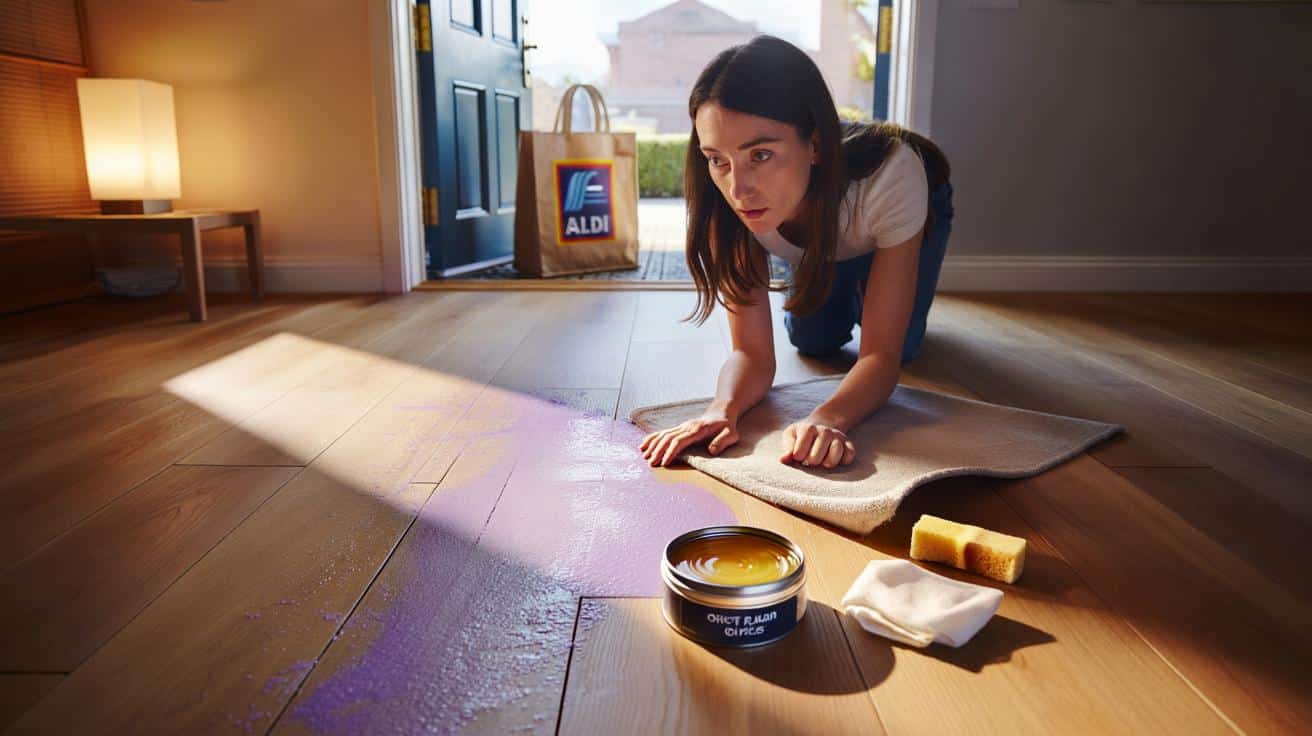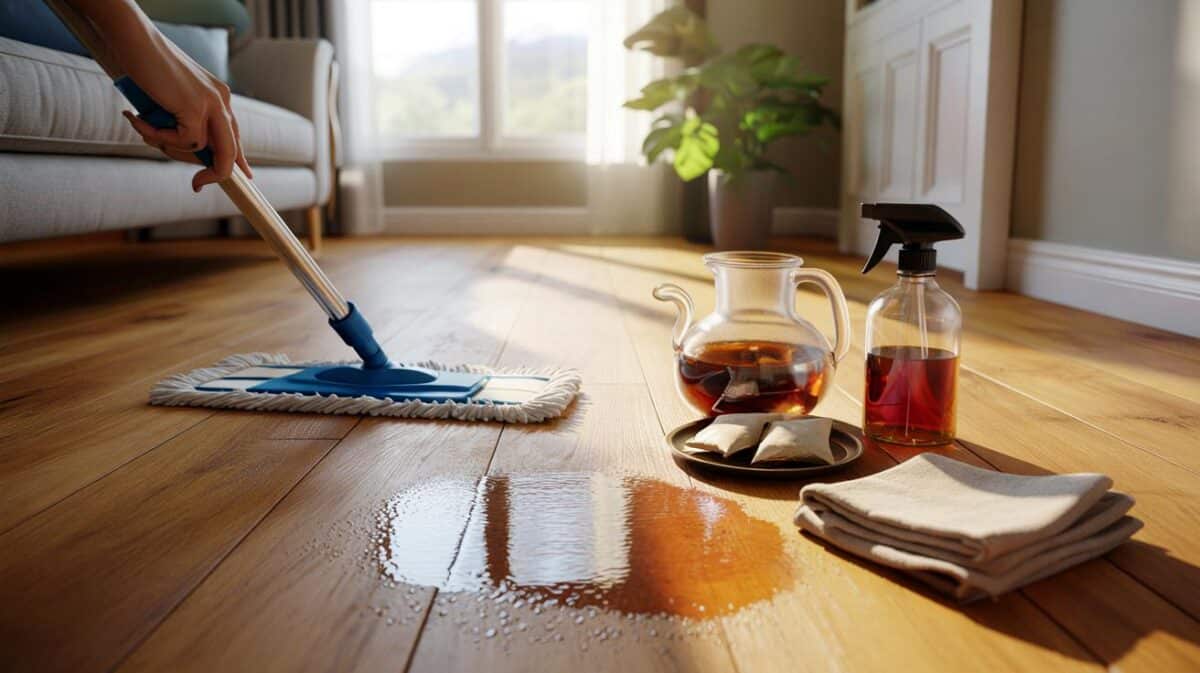Then one woman said it turned her floors purple. From a budget aisle to a living room glow, the story spread fast — part warning, part curiosity.
I watched the light move across a laminate hallway in late afternoon, that grainy hour when even dust looks dramatic. A young mum held up a small pot of soft wax and shrugged the kind of shrug you reserve for £3 fixes. Two swipes with a sponge, a gentle buff, and a quiet pride settled over the room. Then the sun slid behind a cloud, slipped back out, and the boards took on a faint violet bloom. She blinked, leaned closer, and blinked again. Was the floor… purple? She lifted a corner of the rug as if it could answer for the rest of the house. For a second, the colour deepened.
The purple floor mystery that started in a supermarket aisle
In the age of bargain hacks, a “secret” soft wax feels like a wink from one shopper to another. The pot lives on a bottom shelf, half-hidden behind citrus cleaners and mop refills. A whisper goes round: try it on dull floors, it brings back the shine.
Then the claim: a woman online swore her boards turned purple after a single coat. Her clip shows a hallway that looks fine under warm bulbs, then oddly mauve in daylight. It’s not neon, not stain-level dramatic — more like a soft violet veil that won’t blink first.
So what’s going on? Soft waxes aren’t all the same. Some are clear pastes, some carry optical brighteners, and some pull faint tint from dyes in cloths or old finishes. Mix that with LED light temperatures, sun angle, and what’s already in the floor coating, and you can get a surprise you didn’t order.
How a faint violet can happen — and what to do next
Start with a patch test where no one will look: inside a cupboard, under a kickboard, behind a door. Clean that patch with a pH-neutral floor cleaner, let it dry, then apply a pea-sized amount of wax with a white cloth. Buff lightly. Look at it under warm bulbs, daylight, and your phone torch. If the hue shifts toward lilac, you’ve saved yourself a weekend.
If your floor already looks purple, try a simple peel-back. Wipe a small area with mineral spirits on a white cloth, short strokes, gentle pressure. If the cloth lifts grey or lavender residue, keep going in sections with ventilation and lots of clean cloths. No change? Try a wax remover that’s safe for your finish, and always re-test between steps.
There are three common culprits. One: the wax contains optical brighteners that react with cool LEDs, casting a blue-lilac tint across warm wood. Two: dye transfer from coloured microfibre pads, which can leach when solvents hit synthetic fibres. Three: a reaction with an older oil-based finish that has aged toward amber; add blue and you’re flirting with purple. No one expects a £3 pot to rewrite the colour of a room.
Practical fixes, gentle moves, and when to call in help
Method that works in small, sane steps. Switch all lighting to warm white, 2700K, and check again: if the purple fades under warmer light, lighting is amplifying the effect. Swap your cloth to pure white cotton and re-buff a small patch with a tiny bit of neutral paste wax or a dedicated polish rated for your floor type. If you used a coloured mop head, switch to white, then clean with a neutral cleaner and a damp (not wet) microfibre.
We’ve all had that moment when a quick fix grows teeth. If you’re staring at lavender boards, breathe. Take photos in different lights so you can track progress. Work in shoe-box sections — one metre at a time — instead of attacking the whole room. Let’s be honest: nobody does that every day.
Maybe the bargain wasn’t the problem at all. In some homes, the floor finish is the wildcard, not the wax. A thirty-second solvent test can tell you what you’re working with: denatured alcohol softens shellac, lacquer thinner softens lacquer, mineral spirits won’t disturb polyurethane. Once you know the finish, you can pick the safest way to reverse course.
“The colour shift wasn’t visible at night,” one UK homeowner wrote in a popular cleaning group. “It only went lilac when the sun hit the hallway. Changing bulbs helped more than any product.”
- Test under three lights: daylight, warm LED, phone torch
- Use white cloths to avoid hidden dye transfer
- Lift wax with mineral spirits, then neutral clean and re-buff
- If in doubt, patch test or call a finisher for one-hour advice
What this says about bargain hacks, lighting, and trust
There’s a romance to a supermarket solve. You walk in for milk, you walk out with a small promise in a tin. The purple-floor claim taps something deeper — that wobbly line between a hack and a headache. Shoppers aren’t reckless; they’re resourceful, and they want their homes to look good without breaking the month. Light plays tricks, old coatings tell stories, and a cheap wax can either polish the plot or twist it. It’s messy, like most real homes.
| Key points | Detail | Interest for the reader |
|---|---|---|
| Why a purple cast appears | Mix of optical brighteners, existing finish tone, and cool LED lighting creates a lilac shift | Explains the mystery without panic |
| Quick fixes to try first | Warm lighting, white cloths, mineral spirits lift, neutral rebuff | Actionable steps you can do today |
| When to escalate | Identify finish with solvent test; consider pro advice if colour persists | Prevents damage and saves time |
FAQ :
- Does Aldi actually sell a soft wax for floors?Stores rotate seasonal and household lines. Some soft waxes are marketed for wood care and light polishing, but not every region stocks the same product.
- Can a clear wax really make floors look purple?Yes, in certain lighting and with certain finishes. Optical brighteners and dye transfer can shift the perceived colour toward lilac, especially under cool LEDs.
- How do I remove a wax that changed colour?Work in small sections with mineral spirits on a white cloth, then clean with a pH-neutral floor cleaner. If needed, try a wax remover compatible with your floor’s finish and patch test first.
- Will this damage my floor finish?Polyurethane is generally resistant to mineral spirits, while shellac and lacquer are not. A simple solvent test on a hidden spot will tell you which finish you have.
- Should I avoid budget waxes altogether?Not necessarily. Patch testing, neutral cloths, and mindful lighting checks reduce the risk. The smartest product is the one you test before you trust.









